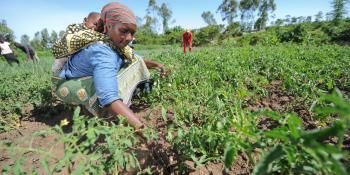With a population of 96.9 million, Ethiopia is the second-most populous country in sub-Saharan Africa (World Bank, 2014). It has a surface area of 1,200,000 km2, of which 65% is suitable for arable farming. The country has one of the fastest growing economies in Africa with an annual gross domestic product (GDP) of approximately USD 54.8 billion (World Bank, 2014).
Agriculture is the country's largest economic sector, contributing about 43% of the country's GDP and employing more than 85% of the working population. Agricultural production systems are dominated by subsistence smallholder farms, which are normally rainfed. Key challenges facing the agricultural sector include over-reliance on traditional modes of production and low uptake of technological innovations, which in turn leads to low levels of productivity. Others challenges include land and resource degradation due to intense cultivation and overgrazing, recurrent drought and unavailable or limited policies governing land ownership and credit systems.
In order to build resilience in agricultural systems in Ethiopia, the CGIAR Research Program on Climate Change, Agriculture and Food Security (CCAFS) promotes innovations by tapping into the expertise of other CGIAR Research Centers, as well as other national and regional research networks. Efforts are focused around the promotion of climate-smart agriculture that facilitates adaptation in cereal-based and livestock systems. In addition, the program works with the Ministry of Agriculture to mainstream climate change into national agriculture plans and agriculture into climate change policy.
Key initiatives in Ethiopia:
Understanding research needs and priorities for agriculture: To raise awareness of climate change and food security and to understand stakeholder needs, CCAFS conducts consultative meetings with a range of stakeholders in Ethiopia. Read more: Climate change vulnerability and risk assessment of agriculture and food security in Ethiopia: which way forward? Additionally read: Agricultural Adaptation and Institutional Responses to Climate Change Vulnerability in Ethiopia
Climate-Smart Villages (CSVs): These are models of local actions that ensure food security, promote adaptation and build resilience to climatic stresses. In the CSVs, researchers, local partners, farmers’ groups and policymakers test portfolios of climate-smart agriculture (CSA) technologies and practices with the aim of scaling up successful innovations. In Ethiopia, CCAFS has established a learning site—located in Borana in the semi-arid lowlands of southern Ethiopia—with an aim of transforming it into a CSV in the near future. Research studies have been conducted together with scientists from Managing Risks for Improved Livelihoods (MARIL) and Oromia Agricultural Research Institute (OARI) to identify entry points for adaptation. Read more: Opportunities and challenges of indigenous biotic weather forecasting among the Borena herders of southern Ethiopia
Rangeland enclosures: CCAFS facilitates the evaluation of sustainable livestock management and feeding options through 20 farmer collective action groups. These include improved range management practices such as the establishment of fenced rangeland enclosures and strategic grazing management. Read more: Rangeland enclosures could help pastoralists cope with climate variability

